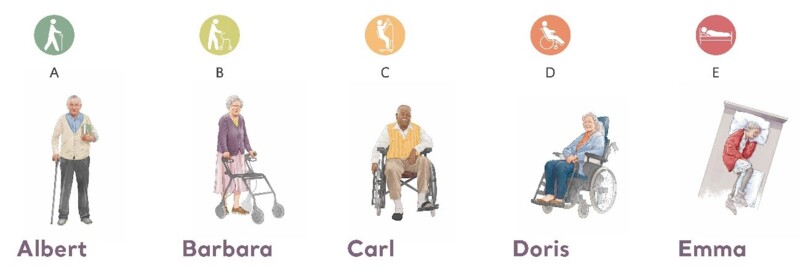The importance of mobilising residents according to their level of functional mobility
From dependent to independent, active participation of your resident should be encouraged through utilising the right care skills, equipment, and transfers appropriate to their mobility level. Even when repositioning a dependent resident in bed, their involvement can make the activity easier for the caregiver, and can promote the dignity of your resident and maintain their level of independence.
Defining each resident’s level of functional mobility
The Arjo Mobility Gallery1 is designed as an assessment and communication tool to determine the functional mobility level of the resident and level of risk to the caregiver.

Learn more about Arjo’s Mobility Gallery here
The five icons communicate two aspects related to mobility; the image in the centre represents the functional mobility of the resident, and the colour represents the risk of physical overload to the caregiver. Residents with reduced mobility present a higher potential for physical overload to caregivers as well as the need for more assistive equipment.
By matching the right transfer solution to the needs of the resident, appropriate equipment can provide a level of support to maintain, encourage and promote mobility.
Active standing and raising
Sit-to-stand hoists are associated with quality indicators of mobility. Their use is one strategy to prevent immobility, which has been shown to be linked to negative outcomes including pressure ulcers2 and falls. Impaired mobility, lack of balance, spatial awareness, or loss of sensory skills can all exacerbate the risk of falling, with a high incidence of falls occurring during sit-to-stand transfers among older adults.3 Using a sit-to-stand hoist can potentially mitigate the risk of falling while offering the resident the opportunity to actively participate in the transfer activity, and may also improve balance and gait.
Sample case study: Forgotten Carl
Who is Carl? Carl needs assistance to perform daily activities.
- Carl is able to partially weight bear on at least one leg, often sits in a wheelchair, and has some trunk stability.
- He is dependent on a caregiver in most situations.
Stimulation of functional mobility for Carl is very important. The mobility needs of Carl may often be overlooked.
Without precautions, assistance of these residents could lead to the risk of physically overloading the caregiver, as well as an increased possibility of falls for Carl.
These residents are able to actively contribute to movement and it is important that they maintain or improve this capacity as far as possible. The assistance provided for Carl might include transfers using Sara Flex or Sara Plus. It is important to stimulate Carl’s remaining capacity and slow down the deterioration of his mobility.
Carl is often over prescribed and under-mobilised through the use of a passive sling and hoist. This can lead to a deterioration of mobility and a reduction in independent movement
Underprescribing for Carl can also have negative effects, increasing the reliance on caregiver for support, as well as increasing risk of falls and reduced dignity for the resident. Choosing the appropriate support – stand aid vs powered standing and raising aid – is crucial. If Carl is unable to pull himself up to standing or lacks the core stability or stamina required to stand for any length of time, he will require a powered standing and raising aid.
An awareness of changes in functional mobility for each resident, and resulting choice of appropriate equipment, will also reduce the risk of injury to the supporting caregiver.
The value of keeping Carl mobile
- Resident mobility is an important clinical issue for improving independence and quality of life.4
- Use of repositioning and transfer technology positively influences the quality of resident care, mobilisation, rehabilitation, and daily life.5
- Use of the right mechanical assistive aids improves caregiver safety and reduces injury-related costs for the organisation.6
- Opportunity for single handed or proportionate care frees staff for other tasks, and for more focused resident centred care.
- Improvement of time efficiencies through using a standing and raising aid rather than a mobile hoist and sling.
Optimising mobility can also reduce care dependency. By promoting mobility, the resident is less likely to become bedbound, and improves their mental health and wellness, which avoids an increased reliance on their caregiver.
Undertaking individual risk assessments and implementing appropriate interventions are key to defining the safe and optimal mobilisation solutions required for each resident’s level of mobility. With the example of the mobility level for Carl, utilising a powered standing and raising aid like the Sara Flex throughout his activities of daily living can help to keep him mobile, retain his dignity, improve his quality of life, reduce the burden on staff, and minimise the risk of injury for both him and his caregiver.
Learn more about Arjo’s Mobility Gallery here
Learn all about our Standing and Raising Aids here
References
- Arjo Mobility Gallery: https://www.arjo.com/en-gb/knowledge/mobility-gallery/ August, 2023
- Gucer et al. Sit Stand Powered Lifts in Long term care and resident quality indicators. American College of Occupational and Environmental Medicine. Volume 55, Number 1, January 2013
- Tinetti M E et al. Risk Factors for Falls Among Elderly Persons Living in the Community. N Engl J Med 1988 Dec 29;319(26):1701-7
- Humrickhouse R, et al. The Ergonomics Open Journal 2016; 9:27-42.
- Matz M, 2019. Patient Handling and Mobility Assessments: A White Paper Second Edition
- Humrickhouse R, Knibbe JJ. The Importance of Safe Patient Handling to Create a Culture of Safety: An Evidential Review. The Ergonomics Open Journal, 2016, 9, 1-16